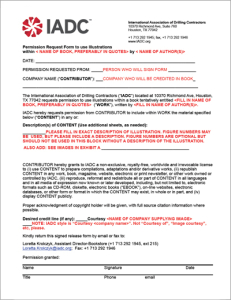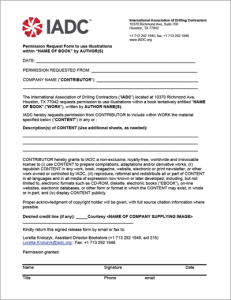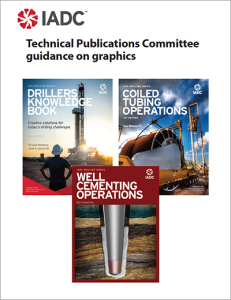TPC Guidance on Graphics
Guidance on securing and using graphics, photographs, or other illustrations in TPC books
Thank you for dedicating your time, talents and energy to write a book that future drilling engineers will find invaluable in their day-to-day work. Graphics, whether actual graphs, photographs, diagrams, flow charts, etc, are very important in helping to communicate your message and to reinforce the lessons of the book. In this discussion, the word “graphics” is used to describe photographs, line drawings, diagrams, and and other types of images. Tables are not considered graphics.
Use and type of graphics
Types of images and their use are discussed in the following paper on “Optimizing graphics in your IADC book”. It describes and contrasts the two major types of graphics, rasters (also called “bitmaps”) and vectors. Rasters, constructed from dots (pixels) are very important but must be high resolution to be publishable. This means that the density of pixels must be high. Little can be done to improve the quality of low-resolution rasters.
Vectors, conversely, have unlimited resolution. They are the best choice for graphs, diagrams, flow charts, and most applications other than photographs. Please refer to “Optimizing graphics in your IADC book” for a detailed discussion.
Gaining permission to use 3rd-party graphics
Unless the author is the originator and owner of any given graphic, permission must be obtained from the rights holder to use the graphic image. Some graphics are in the public domain, including most government images.
However, the images of most use in IADC TPC books are generally owned by private corporations or individuals. Simply because an illustration is posted on the Internet does not mean the image is in the public domain and can be used with impunity. Permission still must be obtained from the owner. This is serious business and can result in penalties to IADC and the author.
IADC has prepared a copyright-assignment form to assist authors obtain this permission. Both a sample blank form and one annotated with instructions are below. IADC will personalize this form for each book/author.
Optimizing graphics in your IADC book
Introduction
Your book represents a wellspring of technical knowledge and information that will benefit our industry for years to come. To illustrate that content to the max, there are certain best practices that, if followed, will bring into the literature the best book possible. Please take a few minutes to review this information. IADC is committed to publishing the highest-quality books for the members of the IADC Technical Publications Committee. The books published thus far represent a tremendous improvement over those produced for the committee in the past. In past books, graphics readability and consistency were often sacrificed. It’s clear that few hand drawings ever received the benefit of redrawing by a graphics artist. In addition, the lack of color in those books is also a barrier to readability and understanding.
Conversely, the IADC Drilling Series features color images throughout, providing much greater clarity of photos and other images. Further, to ensure even greater readability, the TPC wisely requested that books be published at 8-1/2 x 11 inches. This enabled us to print large images. This, in turn, heightens the need for high-resolution images, because enlarging poor graphics is a recipe for disaster, as will be seen.
We are guided by our quest for image clarity and readability, in color whenever possible. First, there are two main categories of graphic formats — raster (or bitmap) and vector.
Raster or bitmap images
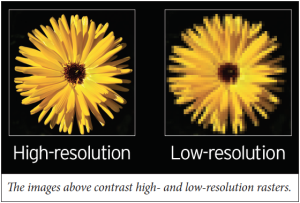 Raster images use pixels to create an image. The more closely spaced the pixels, the higher the resolution of the raster image. Typical rasters include photographs and screen captures. The density of the pixels determines how large the image can be before resolution deteriorates. For publication, resolution should be 300 pixels per inch at the physical size desired to print the image.
Raster images use pixels to create an image. The more closely spaced the pixels, the higher the resolution of the raster image. Typical rasters include photographs and screen captures. The density of the pixels determines how large the image can be before resolution deteriorates. For publication, resolution should be 300 pixels per inch at the physical size desired to print the image.
Raster file formats preferred by IADC include TIFF (also TIF), JPG (also, rarely, JPEG), PNG and BMP (an older format rarely seen today). GIF formats are not acceptable, as they are usually very low resolution.
Evaluating bitmaps
So how can you, a non-graphics professional, determine whether the image is publishable? Here are some quick guidelines to ensuring that your images are high quality:
- High-resolution images are typically large files. File sizes below 500 kb are unlikely to be high resolution, with one major exception discussed below. Generally, high-res images, depending on the physical size of the images, are 1-2 megs or more. It’s not unusual for the file size to be in double or even triple digits.
- An exception: To more easily email high-res images, graphics artists will sometimes stretch the physical size of the image to poster size, which diminishes the pixel density to as low as 72 dpi. Physical sizes of 25 inch x 30 inch are not uncommon. The file size will shrink to quite low levels, facilitating emailing. When physically shrunk to a more usable size, the pixel density increases to a high, publishable level. The key here is, for low-resolution images, that the physical size of the file be very large. If in doubt, check with IADC.
- Please do not capture images from the Internet, save as an example of a desired image. Internet images are low resolution, and are copyright protected.
Vector images
Vector images, in contrast, are not constructed with pixels. Instead, vector graphics uses geometric objects — points, lines, curves and shapes/polygons, all of which are calculated mathematically — to represent images in computer graphics.

Vector graphics can be magnified infinitely without deteriorating, unlike rasters.
Typical vector file formats include Adobe Illustrator EPS, Adobe Illustrator AI, CorelDRAW (CDR) and sometimes PDF. CAD drawings can easily be imported into vector computer apps and used as vectors. The size of a vector file depends on the complexity of the drawing. Simply graphs might be less than 1 meg. However, highly complex drawings can be as large as 100 meg.
Should a file with a vector extension include a photograph, screen capture or other apparent raster image, the file is not a true vector file and will not expand infinitely.
One cannot create vector images by importing bitmaps into programs such as PowerPoint and saving as PDF or in other vector program. However, if graphs or other drawings — emphasis on “drawings” — are provided in PowerPoint, our graphics team can work with them as vectors.
Supplying images
The better the image, the better the book’s appearance, clarity and professionalism.
There are certain recommendations that you can follow to ensure that the best and most appropriate images are used in your book. It is IADC’s goal to produce the most professional and clear books possible. Please take these recommendations into account when choosing graphics:
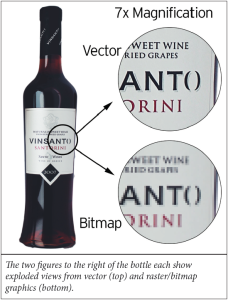 Please do not supply images in Word. This is a convenient method to pass along a number of images. However, inserting the images into Word causes resolution to deteriorate. If you need a handy means to compile a number of graphics, we recommend using a compressing utility and archiving these graphics files into a ZIP file. (However, it is perfectly acceptable to include images within the manuscript, which is usually in Word, to show image placement and caption.)
Please do not supply images in Word. This is a convenient method to pass along a number of images. However, inserting the images into Word causes resolution to deteriorate. If you need a handy means to compile a number of graphics, we recommend using a compressing utility and archiving these graphics files into a ZIP file. (However, it is perfectly acceptable to include images within the manuscript, which is usually in Word, to show image placement and caption.)- Please do not capture images from the Internet with the intent to use the image in the book. Those images are almost always low resolution, and are unusable. Further, these images are almost always copyright protected. Like any image not owned by the author or by IADC, we must seek permission to use the image. (See attached sample permission form.)
- File sizes less than 500 kb are probably less than optimum. File sizes less than 50 kb are almost always unusable, unless run at such a small physical size as to be unhelpful in print or is an exception, as cited on the previous page.


